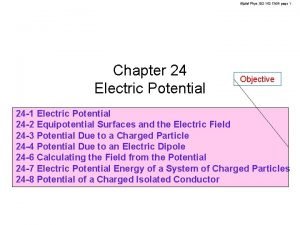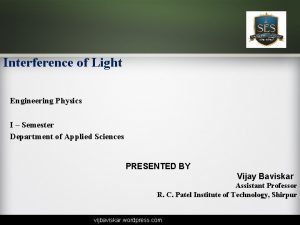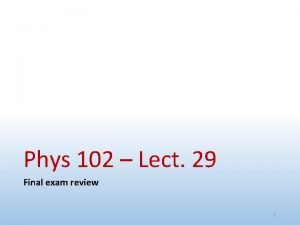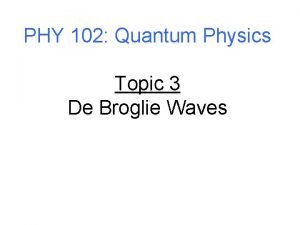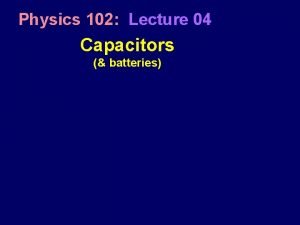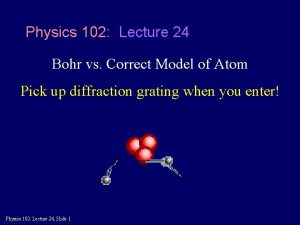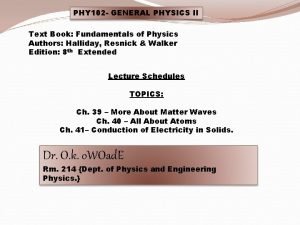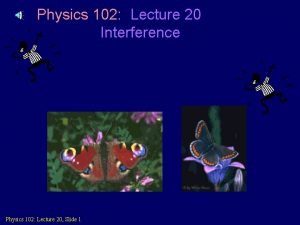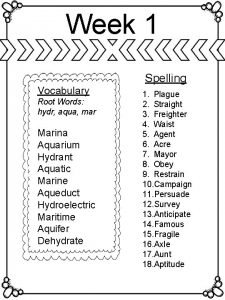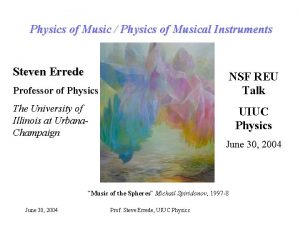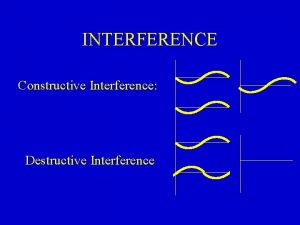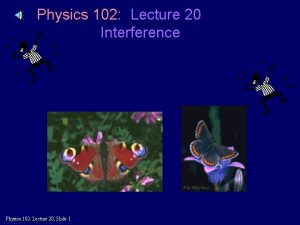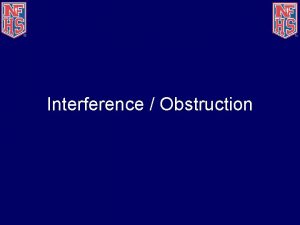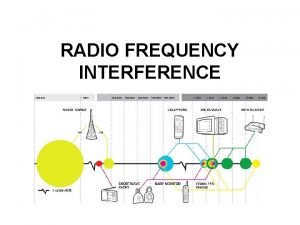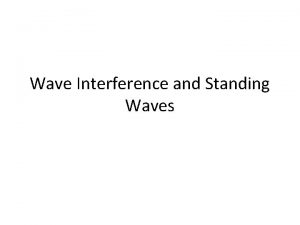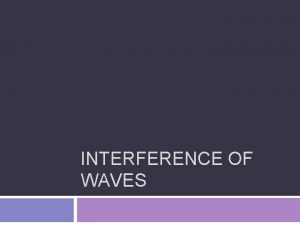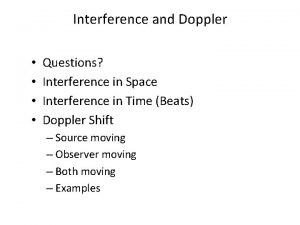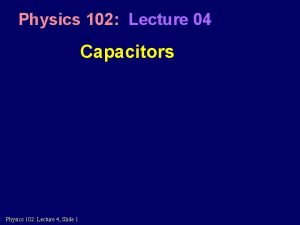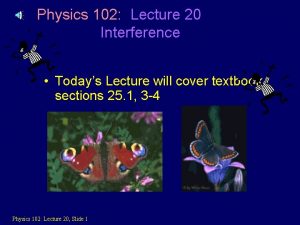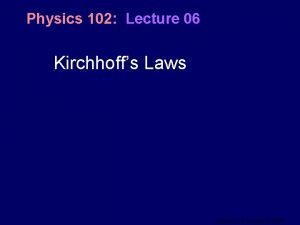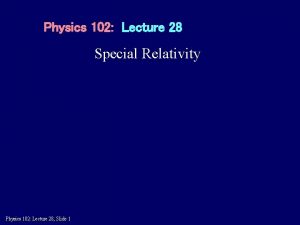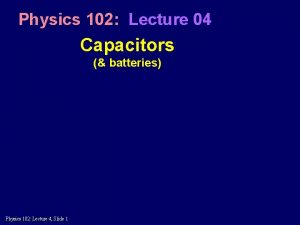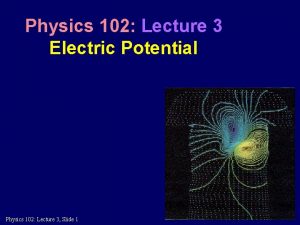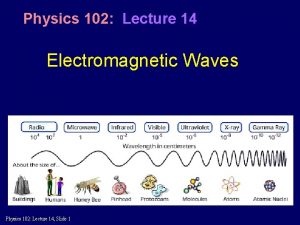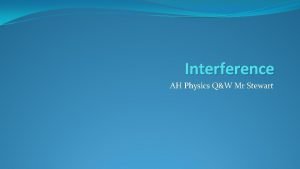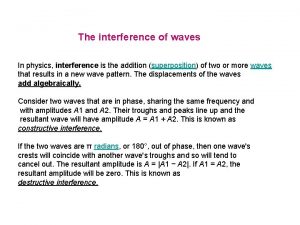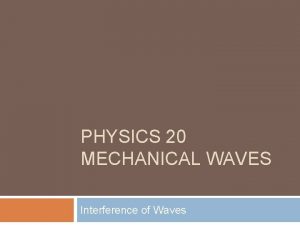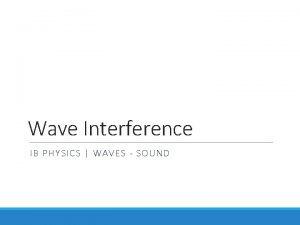Phys 102 Lecture 22 Interference 1 Physics 102
























- Slides: 24

Phys 102 – Lecture 22 Interference 1

Physics 102 lectures on light Light as a wave • Lecture 15 – EM waves • Lecture 16 – Polarization • Lecture 22 & 23 – Interference & diffraction Light as a ray • • Lecture 17 – Introduction to ray optics Lecture 18 – Spherical mirrors Lecture 19 – Refraction & lenses Lecture 20 & 21 – Your eye & optical instruments Light as a particle • Lecture 24 & 25 – Quantum mechanics Phys. 102, Lecture 17, Slide 2

Today we will. . . • Learn how waves interfere In phase vs. out of phase Constructive vs. destructive interference • Apply these concepts Young’s double slit interference Multiple slit interference Phys. 102, Lecture 22, Slide 3

Superposition of waves Two waves are in phase when phase shift is 0 + ____ Wavelength λ = Waves remain in phase with shift of 1λ, 2λ. . . mλ Constructive interference – waves combine to give larger wave Phys. 102, Lecture 22, Slide 4

Superposition of waves Two waves are out of phase when phase shift is λ/2 + Phase shift ____ Wavelength λ = With phase shift of ½ λ, 1½ λ, 2½ λ. . . (m + ½)λ, waves are out of phase Destructive interference – waves combine to give no wave Phys. 102, Lecture 22, Slide 5

ACT: Superposition of waves What kind of interference do these two waves produce? + ____ = A. Constructive B. Destructive C. Neither Phys. 102, Lecture 22, Slide 6

Demo: Interference for sound Pair of speakers driven in phase, produce a tone of single f and λ: Sound waves start in phase r 1 r 2 Bottom wave travels extra λ/2, arrives out of phase, interferes destructively Key is path difference between two waves |r 1 – r 2| Phys. 102, Lecture 22, Slide 7

ACT: Sound interference Two speakers are set up in a room and emit a single 680 Hz tone in phase. r 1 ? Note: the speed of sound is 340 m/s r 2 If you stand a distance r 1 = 4 m from one speaker and r 2 = 5 m from the other, how will the sound waves interfere? A. Constructive B. Destructive C. Neither Phys. 102, Lecture 22, Slide 8

Two-wave interference pattern Interference depends on waves traveling different distances Constructive interference Destructive interference Phys. 102, Lecture 22, Slide 9

Interference requirements Interference is a property of waves. How do we get interference with light? • Need two (or more) waves • Must have same wavelength • Must be coherent (waves must have definite phase relation) • Use one light source with waves taking different paths: Two slits Two different refractive indices Reflection off of two different surfaces Phys. 102, Lecture 22, Slide 10

Recall: Huygens’ Principle Every point on a wavefront acts as a source of tiny spherical “wavelets” that spread outward “wavelet” Planar wavefronts Spherical wavefronts The shape of the wavefront at a later time is tangent to all the wavelets Phys. 102, Lecture 17, Slide 11

Young’s double slit Coherent, monochromatic light passes through two narrow slits Bottom wave travels extra 1λ Both waves travel same distance Top wave travels extra 1λ Phys. 102, Lecture 22, Slide 12

Young’s double slit Consider the interference pattern from a double slit on a screen far away m = +2 m = +1 r 1 d r 2 θ θ d θ m=0 θ m = – 1 m = – 2 Constructive: Destructive: Phys. 102, Lecture 22, Slide 13

Check. Point 1. 1 Now, the light coming to the lower slit has its phase shifted by ½λ relative to the light coming to the top slit. Compared to the usual Young’s experiment, what happens? A. The pattern is the same B. Maxima & minima become minima & maxima Phys. 102, Lecture 22, Slide 14

Checkpoint 1. 2 In the Young’s double slit experiment, is it possible to see interference maxima when the distance d between slits is less than the wavelength of light λ? A. Yes B. No Phys. 102, Lecture 22, Slide 15

ACT: Interference & intensity The two waves are interfering constructively at the point shown. If the intensity of each is I 0, what is the total intensity on screen? m = +2 m = +1 d m=0 m = – 1 A. I 0 4 I 0 B. 2 I 0 C. m = – 2 Phys. 102, Lecture 22, Slide 16

ACT: Check. Point 2. 1 When this Young’s double slit experimental setup is placed under water, the separation y between minima and maxima: m = +2 m = +1 d θ m=0 m = – 1 m = – 2 A. Increases B. Remains the same C. Decreases Phys. 102, Lecture 22, Slide 17

Calculation: Young’s double slit Light of wavelength λ = 650 nm passes through two narrow slits separated by d = 0. 25 mm. Determine the spacing y between the 0 th and 3 nd order bright fringe on a screen L = 2 m away. m = +3 d y θ 3 m=0 L Since L >> d, angles θm are small: Phys. 102, Lecture 22, Slide 18

ACT: Check. Point 3. 1 Light is incident on three evenly separated slits. If wave 1 and 2 interfere constructively at angle θ, what appears on the screen? ? 1 d d 2 θ 3 A. Interference maximum B. Interference minimum C. Somewhere in between Phys. 102, Lecture 22, Slide 19

ACT: Check. Point 3. 3 Light is incident on three evenly separated slits. If wave 1 and 2 interfere destructively at angle θ, what appears on the screen? ? 1 d d 2 θ 3 A. Interference maximum B. Interference minimum C. Somewhere in between Phys. 102, Lecture 22, Slide 20

Interference pattern vs. slit number As number of slits N increases (d remaining the same) angles for interference maxima are unaffected: m = +1 m=0 m = – 1 N=2 3 4 10 100 As N increases, more minima appear and bright fringes narrow DEMO Phys. 102, Lecture 22, Slide 21

Diffraction grating A diffraction grating has a large number N (>100) of evenly spaced slits Astronomy Biochemistry Ex: 1/d = 500 lines/mm Used in spectroscopy – analysis of absorption/emission spectra Phys. 102, Lecture 22, Slide 22

ACT: Diffraction grating White light passes through a diffraction grating and is projected on a screen. Which diagram most accurately represents the pattern on the screen? A. B. C. m = +1 m=0 m = – 1 DEMO Phys. 102, Lecture 22, Slide 23

Summary of today’s lecture • Constructive vs. destructive interference Constructive if waves are in phase (phase shift = 0, λ, 2λ. . . ) Destructive if waves are out of phase (phase shift = ½λ, 1½λ. . . ) • Two slit interference Key is path length difference Interference maxima: Interference minima: • Multiple slit interference Interference maxima: Phys. 102, Lecture 21, Slide 24
 Uiuc physics 102
Uiuc physics 102 Aljalal phys 102
Aljalal phys 102 Aljalal phys 102
Aljalal phys 102 Retroactive interference
Retroactive interference Proactive vs retroactive interference
Proactive vs retroactive interference Phys 241 purdue
Phys 241 purdue Interference of light engineering physics
Interference of light engineering physics 01:640:244 lecture notes - lecture 15: plat, idah, farad
01:640:244 lecture notes - lecture 15: plat, idah, farad Physics 102 final exam
Physics 102 final exam Physics 102
Physics 102 Physics 102
Physics 102 Electric potential lecture
Electric potential lecture Physics 102
Physics 102 Physics 102
Physics 102 Physics 102
Physics 102 Physics 102
Physics 102 Physics 101 lecture notes pdf
Physics 101 lecture notes pdf Classical mechanics
Classical mechanics Wave notes
Wave notes What is a harmonic wave in physics
What is a harmonic wave in physics Atmospheric physics lecture notes
Atmospheric physics lecture notes Phy101 lecture 1
Phy101 lecture 1 Uiuc physics 101
Uiuc physics 101 1 to 25 spelling
1 to 25 spelling Phys 398 uiuc
Phys 398 uiuc

